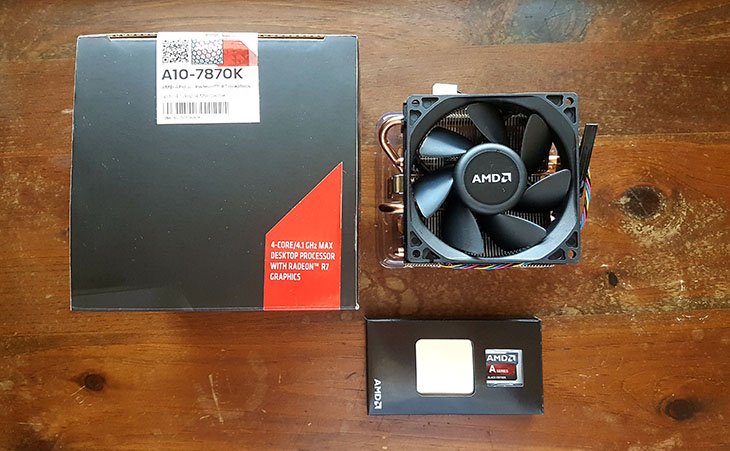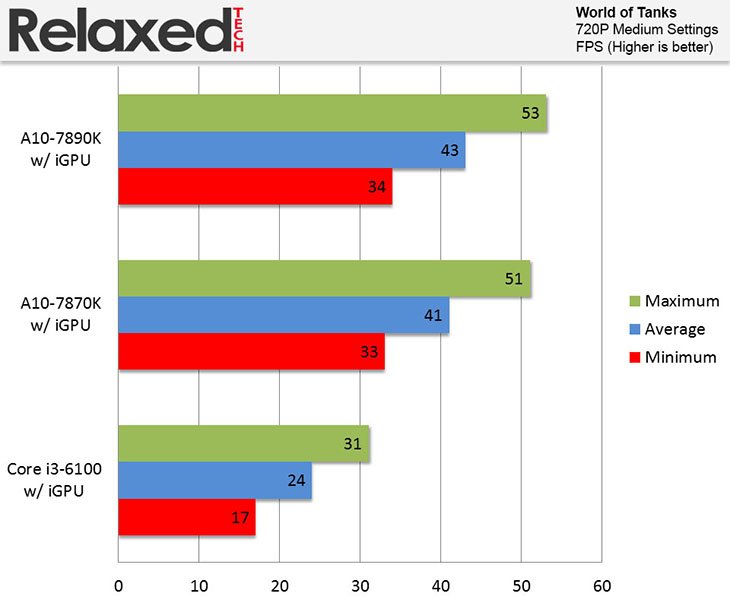
AMD A10-7870K Review: Perfect For HTPC, Office And Light Gaming
Introduction

AMD launched the A10-7870K last year but now it comes bundled with the new near-silent Thermal Solution that's designed to handle TDPs of up to 125 watts. The A10-7870K is identical to the A10-7890K in terms of core counts and TDP but it is clocked 200MHz lower. The base frequency of the A10-7870K is 3.9Ghz and boosts up to 4.1Ghz which makes it the second fastest AMD desktop APU to date. Its got four CPU processing cores and an integrated Radeon R7 GPU clocked at 866Mhz. I have already reviewed the A10-7890K and found it to offer fantastic performance for entry level gaming. You can find the A10-7870K for $140 and the A10-7890K for around $150 on Amazon.
I want to quickly mention that back in February AMD announced the A10-7860K APU that aims to replace the A10-7850K. The A10-7860K is an interesting processor because it has a 65W TDP, full A10 four steamroller cores and 8 GCN Cores with 512 Stream Processors and this makes the A10-7860K the most efficient AMD APU released.
Moving on, the A10-7870K is an unlocked quad-core Kaveri APU with 512 stream processors, 4MB of L2 cache and a 95W thermal design power. Like the A10-7890K, the A10-7870K is also aimed at budget users who play a lot of entry level games and don't really need discrete graphics. Graphics is AMD's big advantage against Intel so you can pair the A10-7870K with a cheap discrete video card such as the R7-250 and run it in CrossFire mode and not only it will be cheaper but the performance will be faster than a system with an Intel i7 5775C without a discrete video card.

The near-silent thermal solution cooler that ships with the A10-7870K is basically the same as the Wraith Cooler that ships with the flagship A10-7890K and FX-8370/50. The difference is that the near-silent thermal solution cooler lacks the plastic shroud and LED AMD logo of the Wraith. You can read my review of the Wraith Cooler if you want to get an idea of the cooling and noise performance.
Comparison
| AMD APU Processors Lineup | |||||||
|---|---|---|---|---|---|---|---|
| Model: | AMD A10-7890K | AMD A10-7870K | AMD A10-7860K | AMD A8-7670K | AMD A8-7650K | ||
| Graphics: | Radeon R7 Series | Radeon R7 Series | Radeon R7 Series | Radeon R7 Series | Radeon R7 Series | ||
| GPU Clock Speed: | 866 MHz | 866 MHz | 757 MHz | 757 MHz | 720 MHz | ||
| CPU Codename: | Godavari | Kaveri | Godavari | Kaveri | Kaveri | ||
| Cores / Threads: | 4/4 | 4/4 | 4/4 | 4/4 | 4/4 | ||
| Core Clock: | 4.1 GHz | 3.9 GHz | 3.6 GHz | 3.6 GHz | 3.3 GHz | ||
| Boost Clock: | 4.3 Ghz | 4.1 GHz | 4.0 Ghz | 3.9 GHz | 3.8 GHz | ||
| L2 Cache: | 4MB | 4MB | 4MB | 4MB | 4MB | ||
| L3 Cache: | N/A | N/A | N/A | N/A | N/A | ||
| TDP: | 95W | 95W | 65W | 95W | 95W | ||
| Socket Support: | FM2+ | FM2+ | FM2+ | FM2+ | FM2+ | ||
The FM2+ socket is nearing the end of its life and AMD's AM4 platform is not expected to arrive till end of this year or early next year. The AM4 socket will become the only socket needed for any AMD Zen processor and it will replace AM1/AM3+/FM2+ sockets. This will make for a clear and easy upgrade paths from entry level to high end hardware.
Test Setup & Power Consumption
| Test Setup | |
|---|---|
| Processor: | AMD Athlon X4 845 AMD Athlon X4 880K AMD A10-7890K AMD A10-7870K AMD FX-6350 Intel Pentium G4400 Intel Core i3-6100 |
| Motherboard: | ASRock A88M-G/3.1 MSI H110M Pro-VD |
| RAM: | Kingston HyperX 8GB DDR3 2133Mhz G.SKILL Ripjaws 8GB DDR4 2133Mhz |
| Graphics Card: | Integrated GPU/Sapphire R9 390X |
| Storage: | Samsung 840 Pro 256GB |
| Power Supply: | Antec HCP 850W |
| Case: | Corsair 750D |
| OS: | Windows 8.1 64Bit |
| Thermal Compound: | Noctua NT-H1 |
| Heatsinks: | AMD Stock Cooler Intel Stock Cooler |
I have prepared a number of different synthetic benchmarks and game benchmarks for the A10-7870K APU. Testing will be conducted by comparing the A10-7870K against the Core i3-6100. The i3-6100 retails for $120 while the A10-7870K retails for $140 so the Core i3-6100 is $20 cheaper depending where you look. Both are popular among users who are on a tight budget that just want to build a dirt cheap gaming rig.
The integrated GPU will be used in the gaming benchmarks. We will be comparing the iGPU in the A10-7890K/7870K against
Intel's HD 530 graphics to see who offers the best gaming performance.
Synthetic Benchmarks:
+ CineBench R15
+ 7-Zip Ultra Compression
+ GeekBench 3
+ 3DMark Fire Strike
Gaming Benchmarks:
+ World of Tanks
+ Counter-Strike Global Offensive
+ F1 2015
+ DOTA 2
+ World of Warcraft
+ Battlefield 4
+ Witcher 3
+ Tomb Raider 2013
+ GTA V
All of the testing is done with an ambient temperature of ~19C.
CPU-Z will be used to verify the CPU speed and the voltage being used in Windows 8.1.
Also, the CPUs are tested with the default settings (Turbo, C1E etc) enabled in the BIOS.
Idle power consumption of the entire computer will be measured after leaving the computer idle for 20 minutes. Load power consumption of the entire computer will be measured after playing Counter-Strike GO on max settings at 1080P for 20 minutes. I want to make it clear that the power consumption measurements will differ per computer and components from my measurements if you add optical drives, HDDs etc.

In idle state, the i3-6100 draws 27 watts while the A10-7870K draws 35 watts. When playing CS:GO, the i3-6100 draws 66 watts and the A10-7870K draws 91 watts.
CPU Performance Results

Cinebench R15 is the perfect benchmarking tool for comparing CPU performance across various systems and platforms.
Looking at the chart above, we can see that the A10-7870K offers decent single and multi core performance but the i3-6100 clearly wins this test.
I'm amazed at how great the X4 845 is. Despite being clocked lower and having only 2MB of L2 cache,
it performs almost on par with A10-7890K/7870K and X4-880K.

The Core i3-6100 was able to finish this test in under 10 minutes with the A10-7890K/7870K coming in at 12 minutes.

Geekbench 3 is a benchmarking software for processors that separates single-core and multi-core performance.
Geekbench 3 shows the i3-6100 winning in both single and multi-core performance.
The A10-7870K performed relatively the same as the X4-845 and A10-7890K.

Here we see the core i3-6100 coming in on top with 6391 points and the A10-7870K with 4758 points.
AMD A10-7870K In Gaming

World of Tanks is a free-to-play tank shooter game that is based on war conflicts from the mid-20th century.
This game is not too demanding so we set it to 720P with medium settings.
The i3-6100 struggled a lot and couldn't manage to deliver a playable gaming experience.
On average, both AMD's APUs were able to deliver more than 40fps which makes the game playable.

With the fast-paced nature of CS:GO, you need a video card that can deliver 60fps at all times.
Intel's i3-6100 wasn't able to deliver 60fps on average.
The A10-7890K/7870K performed much better and had no trouble maintaining above 70fps.

Moving on to F1 2015 benchmark, the i3-6100 fell behind while the A10-7890K/7870K did much better.

Some settings were turned to low in DOTA 2.
DOTA 2 relies heavily on the GPU so once again we see AMD's APUs performing much better than Intel's i3-6100.

The minimum FPS was about the same on all three processors but AMD's APUs delivered about 5-6fps higher on average.

BF4 is another GPU intensive game so here we see the A10-7890K/7870K beating the i3-6100 again.

The A10-7890K/7870K destroyed Intel's HD530/i3-6100 in Witcher 3. The i3-6100 stuttered a lot and the game was beyond unplayable.

Most of the settings in Tomb Raider 2013 were turned to medium with some to low.
The game was somewhat playable with Intel's HD530/i3-6100 but it still didn't perform as good as the A10-7890K/7870K.

In GTA V, AMD's APUs performed similarly the same delivering above 55fps on average while the i3-6100 maintained around 40fps.
Overall, the A10-7870K performed much better than the i3-6100 in all the games that I tested so if gaming is your top priority then the A10-7890K/7870K might be what you need.
Value & Conclusion
Since I have already reviewed the A10-7890K, this conclusion page will be similar to what I wrote about the A10-7890K. At $140, the A10-7870K isn't expensive and it offers a great gaming experience at 720P and it can certainly play most games at 1080P with some settings turned down. Not needing to purchase a discrete video card to play entry level games at playable fps is what sets the A10-7870K apart from the Core i3-6100. The A10-7870K is also plenty fast for everyday usage like browsing the Internet and office applications and it can certainly handle all the Adobe applications (InDesign, Illustrator, Photoshop, etc) with little effort.
If you want to build a cheap HTPC then the A10-7870K might be perfect for you. HTPCs don’t require much processing power so the A10-7870K hits a sweet spot between price and performance. As you saw on the previous page, the A10-7870K beat Intel's HD 530/i3-6100 in all the games that I tested and it wasn't even close. The A10-7870K's iGPU can handle most games at medium settings just fine and the CPU performance is decent.
The bundled near-silent thermal solution cooler keeps the APU nice and cool at all times.
It provides plenty of headroom for overclocking so you can easily push the A10-7870K to 4.3Ghz+.
The A10-7870K supports dual graphics so you can pair it with the R7 250 for the best gaming experience.
What you have to keep in mind when running dual graphics is that both video cards have to be running at the same speed otherwise it won't work properly.
Pros:
+ Dual Graphics Support
+ Low Power Consumption
+ Affordable Platform Price
+ Fantastic Gaming Performance
+ Silent Stock Cooler
Cons:
- Slow Single-Core Performance
- No Upgradeable Path
Overall, if you are a gamer on a budget that mostly plays entry level games then the A10-7870K APU is perfect for you. It can easily handle entry level games such as DOTA2, CS:GO or WoW at 1080P on high settings. The FM2+ platform is affordable and is great for users who are on a tight budget that just want to build a nice cheap gaming machine. Intel is still behind AMD in the graphics department so if gaming is your priority then get the A10-7870K.
Final Score 9.0
